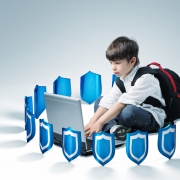What You Can Do as a Parent to Prevent Cyber Bullying
Young people especially students are now using technology and digital devices both in and out of school, from smartphones and laptops to text messages and social media. While this grants them more resources and efficiency in terms of searching for information, this also means that they are at risk of being a victim of cyber bullying or becoming cyber bullies themselves.
The Guardian reported that one in five children are victims of cyber bullying. This is a major statistic we shouldn’t ignore. Parents are usually the first line of defence for our young people and, as a parent, there are many constructive things you can do to protect them from the dangers of cyber bullying.
What Is Cyber Bullying?
Cyber bullying happens when someone uses technology to offend or harass someone. This includes using digital and online services such as email, text messages, and social media—all of which today’s students and teens are using more and more for studying, socialising, and entertainment. Not only are young people at risk of being victims of online bullies, they could also unwittingly become cyber bullies themselves, which could have serious implications on their reputation, social interactions, and future plans.
How Parents Can Help
Some forms of cyber bullying are obvious, such as when someone contributes to unkind online gossip or posts images that are solely meant to hurt or upset someone. Other examples of cyber bullying are less apparent. For example, repeatedly sending unwanted messages and behaving in a way that could be construed as stalking or creating a fake social media profile in someone’s name and using that profile to post offensive material.
As parents know their children better than anyone, they represent valuable potential when it comes to preventing the proliferation of cyber bullying. Below are key insights to help you get started.
Communicate with Your Kids
Talk to your children and gain their trust. This means using language they understand so they are clear about what is right and wrong. Don’t assume they understand all technical jargon. Make sure they know what to look out for and that they feel comfortable in coming to you if they are subjected to content which could be upsetting or offensive. Keep reminding them about what to be aware of and ask them open-ended questions so you know how they are feeling. Also remember to be patient, as children tend to ask questions—this is actually a good sign which shows that they are open to communication.
Set a Good Example
Encourage them to post positive or empowering content on social media by setting a good example. Explain what harm they can do by posting content that is offensive or upsetting. Share stories with them about what you’ve found to be offensive and talk to them about cyber bullying in the news, so they know these things happen and that they can do something to deal with it and be positive examples themselves.
Keep an Eye on Their Internet Use
Older children don’t want parents reading every message they send and, usually, parents want to respect their privacy as well. However, you can have an open-door policy at home, so you can see at a glance what sites and social media platforms your kids are using and who they are talking to. If children use computers and smartphones in the family living area, it will be even easier to keep an eye on them without having to actually impose on their personal space.
Be Aware That They Can Become the Bully
Peer pressure and wanting to look popular in front of their friends may result in children and students posting inappropriate content or sending hurtful messages. This is something that parents should consider—being aware of this truth helps puts things into perspective when it comes to cyber bullying prevention. Knowing they can become cyber bullies means you are aware that you also have to prevent them from sending offensive content.
Here’s something Starshell Student can help you with—it functions as a cyber bullying education and prevention platform that alerts students if they try to post content on social media that could be regarded as explicit, racist, sexual, or harmful to their reputation. They are also given a link to their school’s social media guidelines to remind them of what they should and shouldn’t send. This way, they are shown how to become responsible users of social media not through punishment but through education.
For older children and students, you can tell them that Australia has laws pertaining to serious online harassment and bullying. The maximum penalty for adults is three years imprisonment or a fine of more than $30,000. There are also heavy penalties for persistent online stalking where a person is made to feel scared, offended, or harassed.
Educate Yourself
Education and awareness are the first steps in your campaign to stop bullying, online or offline. How can parents help their kids if they don’t know what the symptoms of cyber bullying are, and the tools or avenues used to spread it? 96% of parents say they need additional online safety information to help them manage the risks of cyber bullying. Educate yourself and stay abreast of current techniques, technologies, and strategies that online bullies use. Doing so keeps you aware of what to look out for in terms of cyber bullying trends, keeping you prepared and informed.
Don’t Wait
If you have any suspicions, act fast. Find out the facts and speak to the school so you can take steps and work together to protect your children from harm. You can report cases of cyber bullying to the Office of the eSafety Commissioner and they will work to get the bullying material removed.
Set up Parental Controls
You can monitor what your children do online with parental controls (which are packaged with many digital devices and services such as web browsers and anti-virus software) and using a child internet monitoring tool for parents. When needed, you can also use these to limit the types of content your children view online, protecting them from viewing potentially harmful material.
When it comes to dealing with cyber bullying, parents, teachers, and students all have a role to play. Through Starshell Student, these roles are efficiently and intuitively consolidated into one effective platform that serves as a cyber bullying prevention and education tool. Of course, it’s always better to have numbers on your side, so we encourage you to become a part of our community as well. Contact us to find out more about our platform and help make the internet safer for kids today.









